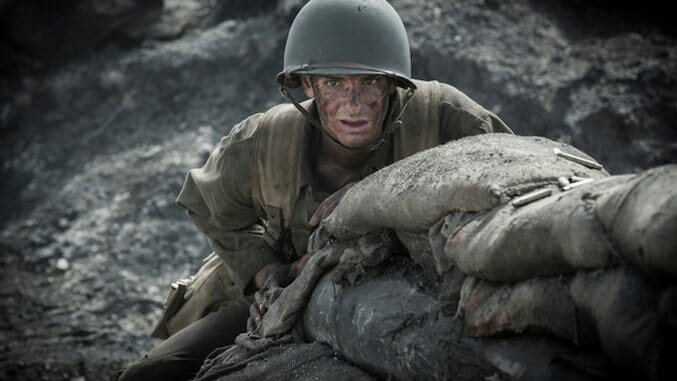
Grant that it’s possible to honor and respect the positions of the conscientious objector who refuses to kill and that of the soldier who ends life to stop what he would consider a greater injustice. The issue with Mel Gibson’s Hacksaw Ridge isn’t that it sets itself the task of dramatizing respect between the two and garnering empathy from viewers for each. Rather, it’s that each standpoint within the film exploits the other to manipulate the audience.
Based on the true story of Desmond Doss, the first conscientious objector to earn the Medal of Honor, Hacksaw Ridge foreshadows its hero’s journey by opening with Doss in the thick of World War II combat in Okinawa. With the stakes established, it shifts back to his boyhood in the Blue Ridge Mountains of Virginia. Familiar elements are writ large for audience sympathy: the alcoholic father, the nobly suffering but assertive mother, the courtship of a local nurse with whom it’s love at first sight. So strong is the kitsch, it’s tempting to think that Gibson is trying for a ham-handed juxtaposition against the bloodshed we know is to come. Andrew Garfield (The Social Network, The Amazing Spider-Man) is in sync with the tone. He plays the adult Doss with an aw-shucks naiveté that is ingratiating and maybe just occasionally cloying.
This old-fashioned approach continues when Doss enlists to do his part in the war. Basic training includes an ethnic melting pot of hard-nosed and jocular army buddies with names that sound like they were conjured out of a fevered dream of 1940s Hollywood. Doss is just one of the boys until they learn about his stipulation: He refuses to use or even carry a weapon, a position he attributes to his religious beliefs as a Seventh-day Adventist. Instead, he wants to fulfill his obligation as a combat medic. The stressors and conflicts pile up: a looming court martial, the pressure to break one’s code, an anguished fiancée waiting for Doss’ safe return.
A cast dominated by a host of Gibson’s fellow Aussies doing the square American accent is quite good. But it’s an actor sporting the real deal who sticks out a bit much. The perpetually sardonic Vince Vaughn is the sergeant who must whip Doss and the other greenhorns into shape and help lead them against the Japanese. Vaughn, as you’d expect, is a hoot at delivering a string of withering put-downs of the new recruits, and he even cuts a commanding figure on the field as a leader whom his soldiers will follow into battle. But it’s still hard to forget that we’re watching a guy best known for his sarcastic comic persona become a crack shot in military fatigues.
The shift to Okinawa and the battle atop Hacksaw Ridge is freighted with our need to see Doss prove himself. He comes through for the blood-spurting casualties—otherwise we wouldn’t have this movie—amid intense gunfire that Gibson stages for maximum visceral impact: The results are brutal, even by the standards of other war films noted for their realism. Gibson’s camera moves deliberately through the carnage as our guide into the ultimate house of horrors. While this half of the film upends much of the small-town melodrama with startling depictions of blood and guts, what unites the two is an approach that doesn’t entirely trust the viewer to come to their own conclusions about what to think and feel.
Your reaction to Gibson’s immersion in the violence may rest on whether you think it is acceptable because it reflects the reality of war, or if the combat scenes exist on a spectrum that ranges from being immodest to tasteless. Go ahead and divorce these depictions from whatever prejudices you may have about Gibson’s reputation for cinematic bloodlust. Even granting Gibson that distance, his staging of the fight atop Hacksaw Ridge is much like a series of shock scares, with each death timed for maximum jolt value. Filmmakers who try to earn cred in their war films by upping the graphic body count end up missing what the best directors have showed us: It’s not the flying limbs that make war hell, it’s the cruelty that motivates men to dehumanize and destroy one another.
There’s little reason to doubt that Gibson and screenwriters Robert Schenkkan and Andrew Knight respect Doss’ thou-shalt-not-kill position. One key line finds Captain Oliver (Sam Worthington) explaining to Doss that while his compatriots don’t believe what he believes, they respect him for it. There’s enough to figuring out the nature of that belief that it warrants a deeper exploration. We know fear of punishment isn’t guiding Doss. And it’s unlikely that he believes in the relativity of his approach. But we wonder to what extent his refusal to kill is rooted in the fear of living with guilt or if it’s simply a matter of believing that it’s immoral by God’s will. If it’s the latter, it’s tough to reconcile his position with his willingness to fight alongside those who are taking lives.
That conundrum aside, Doss deserves praise for his heroics in these circumstances, and Hacksaw Ridge is passionate in arguing that asking someone to act against their own moral convictions is wrong. What pulls us out of the film is a presentation that is too self-aware of its gravity and its status as a Big War Movie. It’s an approach that occasionally works against dramatic impact when the swelling score is imploring us to feel otherwise. Even accepting that everything depicted about Doss’ heroics are true, Hacksaw Ridge delivers them like someone too intent on wanting to make us feel good about ourselves for honoring the bravery and sacrifice of those soldiers. Where a less manipulative approach would be more respectful and powerful, Gibson opts for discomfiting obviousness.
Director: Mel Gibson
Writers: Robert Schenkkan, Andrew Knight
Starring: Andrew Garfield, Teresa Palmer, Sam Worthington, Hugo Weaving, Luke Bracey, Vince Vaughn, Rachel Griffiths
Release Date: Nov. 4, 2016